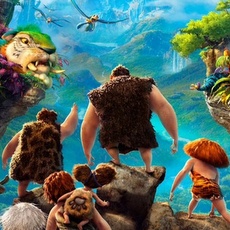May 18, 2001 saw the release of DreamWorks Animation’s Shrek. Eleven years, three sequels, and three and a half billion dollars later, it’s safe to say that they did something right. One of the men behind the fifth highest grossing series of all time is Chris Miller.
Miller joined DreamWorks SKG in 1998 and worked as a storyboard artist on Antz. He then worked as a story artist and added additional dialogue for Shrek, as well as provided the voices for Gepetto and the Magic Mirror. After serving as head of story on Shrek 2, he co-directed and co-wrote Shrek The Third.
Following the popularity of the Puss in Boots character in Shrek 2 and Shrek The Third, a spin-off was announced, and Miller landed his first solo directing gig. Puss In Boots was released on October 28, 2011, and proved to be a box office and critical success, earning $516,267,034 and universally positive reviews.
When the Academy Award nominations were announced, Puss In Boots scored Miller his first Oscar nomination for Best Animated Feature. Puss In Boots hits home video on February 24, two days before the Oscars, and Chris Miller talked with Animated Views about it all.
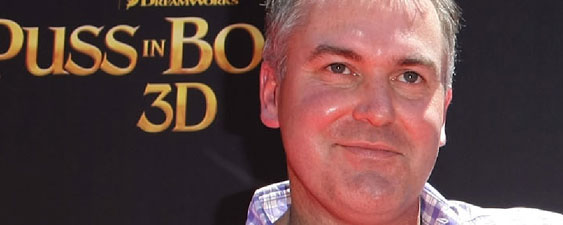
Animated Views: First off, congratulations on the Oscar nomination!
Chris Miller: Thank you.
AV: Were you watching the live broadcast or did you find out later?
CM: I didn’t make it to the live broadcast, or wasn’t trying to make it, but I didn’t go to sleep until very late so I slept through it. I had plans of watching but slept through it, so it was a nice wake up call.
AV: How did you become the director of Puss In Boots?
CM: I worked on all the Shrek films, minus Shrek Forever After. I wasn’t on Shrek Forever After because I was making Puss In Boots at the time, but I always loved the character since Shrek 2. I was head of story on Shrek 2 and always was a big proponent of him getting his own film, and the studio was even into way it way back then. It just took a while to get the right story. I was coming off of Shrek The Third, I directed that, and I was fortunate with the timing. It was right when Puss In Boots was about to kick in and so when I got the opportunity I jumped on it.

AV: You said you really loved the character, and it is a very popular character, but what about Puss in Boots interested you in giving him his own movie rather than any other Shrek character?
CM: I always thought that the character had this amazing history to him. There was something really intriguing about him. He was always, even in Shrek 2, referring to these past adventures that he’d had, and all these places he’d been. He had been everywhere and done everything. It made me curious. Why is this Spanish cat wearing boots and where did he get the boots? Where did he get the hat? And what’s his story? And from the persona, which Antonio Banderas poured into that cat, I knew that there was something sort of epic and legendary behind him. He is equal parts fighter and lover. He has this great capacity for love and an incredible heart, but he has this devilish side to him. There’s something in that cat for everyone, I think. And I think it’s why so many people were so naturally attracted to him.
AV: When I first read that Guillermo del Toro would be working on the film I was interested to see what his contributions would be. Could you describe working with him on the movie?
CM: Guillermo had a great impact on the film. He came in, and it was really kind of dumb luck. He was just coming off The Hobbit and I had just read about it in the trades that morning when I found out that very same day he would be coming to the studio. It just so happened that we were showing a screening of the film. We were about half way done. Some parts were animated, most parts were just storyboarded, but you could watch the film. The whole thing was there. We invited him to the screening, he accepted the invitation, and he came out of the film and loved it. And he asked us if he could be a part of it somehow, which was a total gift to us.
In the next twenty-four hours he was executive producer. He was invaluable, I really have to say, in so many different ways. He understands character, he understands storytelling so well. He just has a great creative mind. So initially we would just bring Guillermo in once a month or every few months, and just show him artwork from different parts of the movie and let him react to it. He knew the pathway that we were on and he was great at just encouraging us and pushing us creatively. If we were ever stuck with a character or a story point, we would bring Guillermo in. I always made sure he had fresh eyes. That’s also the way he wanted to participate.
He didn’t want to be there every day, because he didn’t want to completely fall in love with the movie and lose his objectivity. He loved the film and really wanted to help it out in the best way he could. He was great in the editorial. He offered a lot of things to the character of Humpty. Guillermo loved that he was a schemer and a thinker and helped us visualize it by offering the idea of him being like da Vinci. He builds things and is constantly designing apparatuses and I think it worked out great.
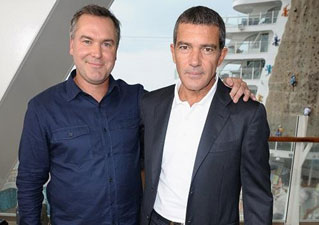
AV: Were there any other fairy tale characters that were originally going to be in the movie that didn’t make it to the final cut?
CM: Wow, that’s a good question. It’s pretty much what you see is what you get in the film. The only big change that happened, it was something we struggled with for a long time, was the giant. We had the giant’s world figured out, but the character of the giant was really challenging for us. We wanted to just make a straight up giant, like a real fairy tale legendary giant. And no matter how hard we tried to twist the character there was something about it that felt so expected. Once you did see him it wasn’t surprising, no matter what we did. [SPOILERS] So killing the giant was one of the better decisions I think we made, ultimately, in favor of a giant goof instead. [END SPOILERS] We are always looking for ways to subvert fairy tale expectations. That was important to us.
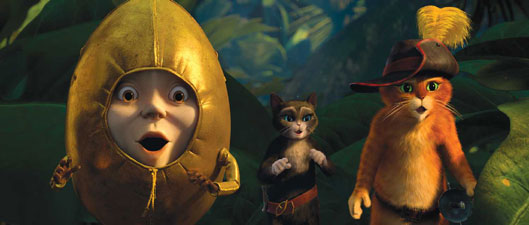
AV: You mentioned Humpty Dumpty earlier. When you have someone like Zach Galifianakis playing him, was there any improvisation or did you stick mostly to the script?
CM: With Zach, there’s quite a bit of improv. It was the first time he had ever done voiceover work, so it was a very new experience for Zach; but I have to say he tapped into it pretty quickly. We always had the script that we’d bring in, and usually within the script we’d have alternate versions of lines for him. And a lot of it was just to get his brain going and get him warmed up. If something spoke to him, and he could improv it or come up with new material, we encouraged it all the time. I think Zach contributed improv a lot in the film and we wanted him to embrace the character and make it himself. I think he did that by either finding it in the writing or finding it some other way.

AV: Besides adding him, you also added Billy Bob Thornton, Amy Sedaris, and Salma Hayek. Were they all in mind from the beginning, or did they join later in the process?
CM: We wanted them early on. We really got every player that we wanted. And Billy Bob, the guy has a great voice and is actually very funny too. I just thought that was a total long shot that we wanted and he came in and was kind enough to take the part. I was kind of amazed. Same thing for Billy Bob— he’s never done voiceover before. (Editor’s note: Thornton did provide a voice for the English version of Princess Mononoke, though it was carefully-scripted dubbing, as opposed to a role that would allow improvisation.) I think he enjoyed that experience. He’s such a great actor and filmmaker. But I also think Billy Bob Thornton is looking to challenge himself and step outside of his comfort zone. We were fortunate to get him. It was amazing. And Amy Sedaris, I had worked with her before, but talk about improv. There is no one who works better off of a page than she does. With Amy we’d write lines that we knew were just in the ballpark that we needed and honestly she would give us fifty different versions of something, and that’s no exaggeration. Probably ninety percent of her dialogue came out of her brain.
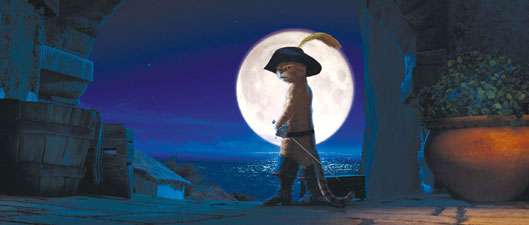
AV: Are there any plans for a Puss In Boots sequel?
CM: We’ll see, we’ll see. I personally would love to see that happen. The character is set up for any number of adventures. They can get more fantastic and they can get a little more surreal, and funnier. Once you find a good story for him, you could do many of them. But we’ll see. We evaluate how audiences react to the film and if they’re excited for more.
AV: What are you currently working on at DreamWorks?
CM: Right now just developing some things. And we’ll see what happens in the next few months. But that’s where I’m at and it’s a nice place to be for right now.
Puss In Boots will be available to own on DVD and Blu-Ray on February 24th.

Thanks to Chris Miller and DreamWorks Animation.






